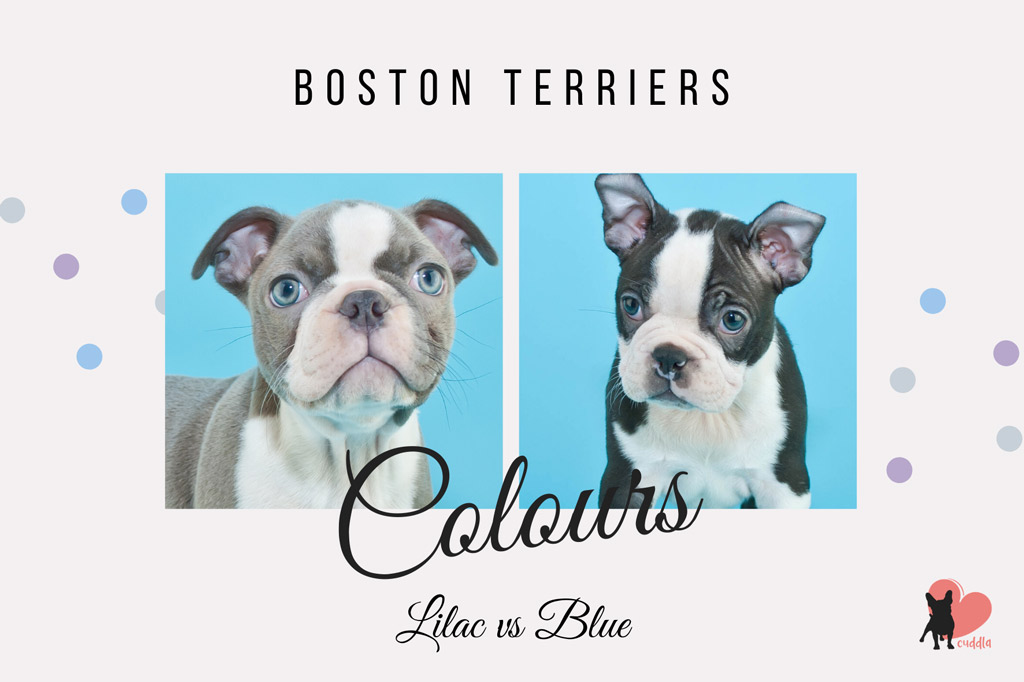
Grey, lilac, or blue Boston Terrier puppies have become popular. But, does a Boston Terriers colour have a wider significance? e.g.:
- Can you register them?
- Is blue part of the breed standards?
First, let’s start with the question…
What is a blue Boston Terrier? Blue Boston Terriers have a lighter coat that looks grey, lilac or blue. The blueish tone is a dilute of black due to a mutation of the dilution gene, known as Chromosome 25 in canines.
In fact, Boston Terriers can have many different colours and you’ll find a list of them below.
Also, here you’ll discover what the official dog breed standards say about the Boston Terrier’s appearance.
Blue Boston Terrier
Now that you know that blue Bostons are a thing… Let’s see where this colour and others come from. 🙂
I must confess that, at first, I found it difficult to differentiate blue vs lilac Boston Terriers. Hopefully, their appearance descriptions below will shed more light if you are also in doubt.
What Is a Blue Boston Terrier?
Blue Bostons have a blue and white coat, which is also referred to as grey, silver, or lilac and white.
Blue is a dilute (weaker/lighter tone) of black, and blue Boston Terriers are the result of the dilution of the black pigmentation in their coat. The blueish tone is a dilute of black due to a mutation of the dilution gene, known as Chromosome 25 in canines.
The diluting of the eumelanin (black) hair and pigmentation causes a black and white coloured Boston to become diluted. So, instead of being black, the coat appears to have a greyish appearance.
The Cypress Farm Kennel, where they have blue Bostons but don’t specifically breed them, explains Blue Bostons’ appearance:
- Blue pups have a blue and white coat, which is light to medium blue and darken with age (becoming a hue of a medium to dark steel blue).
- They can have white markings in nose, paw pads, and eye rims.
- The blues that seem to stay the lightest are the blue Boston Terriers with the heaviest brindling (brindle coat instead of black). This is due to the lighter colour of the brindle enhancing the dilution of the coat.
- Usually, their iris colour is grey (which can look like light blue) but usually darkens to a brown (hazel-brown) into adulthood.
According to the AKC, the Blue colour is not included in the Boston Terrier breed standard. That’s why Blue Boston Terriers don’t qualify for the dog shows.
However, you can register your pup if the parents are already registered with the American Kennel Club (AKC).
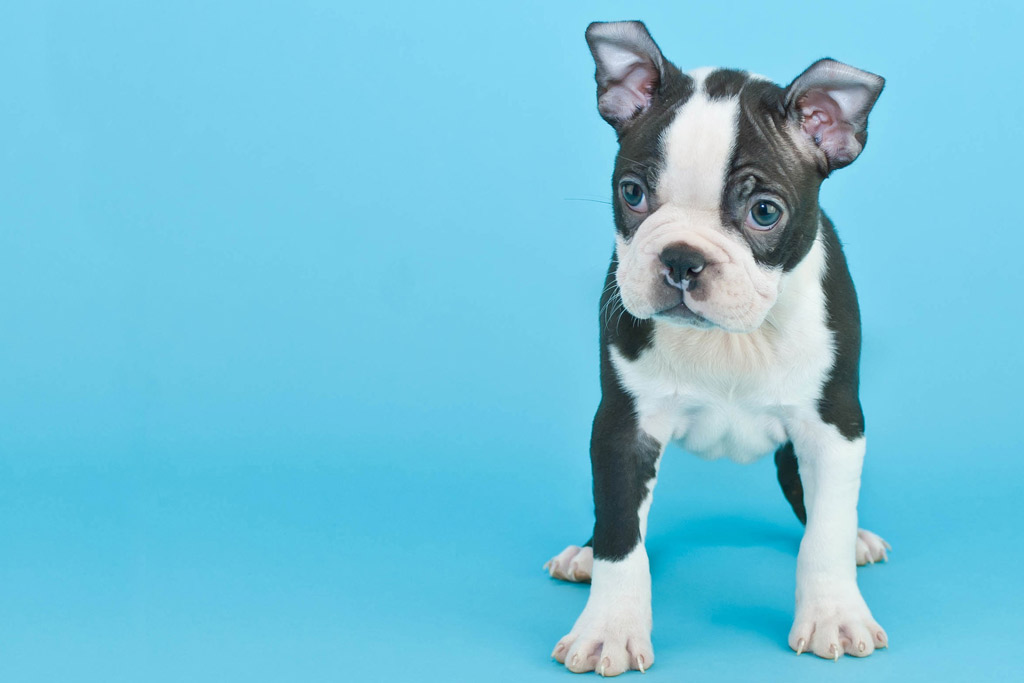
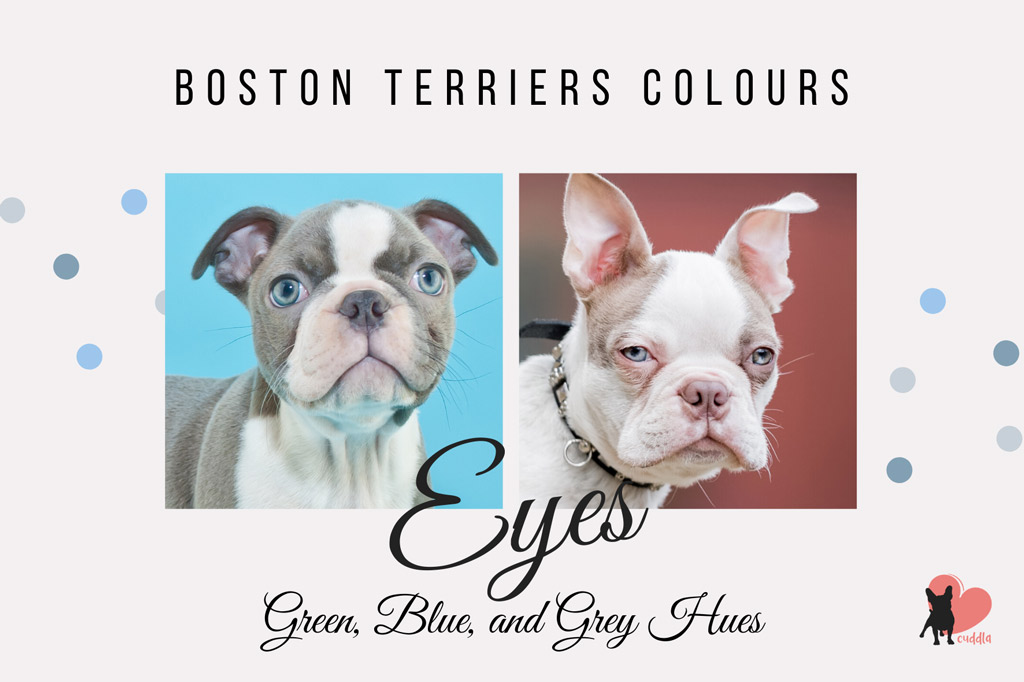
What Is a Lilac Boston Terrier?
If blue is a dilute of black, lilac is a combination of the dilute of black and brown coat (referred to as seal colour on the breed standards).
Lilac and white Boston Terriers have a hue of diluted brown.
According to the Cypress Farm Kennel, since lilac is a combination of black dilute and brown, you need a pair of each to produce this colouration.
This means that there must be a double copy of recessive dilute (d/d) and a double copy of brown (b/b) within the genetic colour code. If one set of copies is not present, no lilac can result.
Lilac Bostons’ appearance:
- Their coats are typically a distinct purple/blue in hue, sometimes resembling a very dusty red.
- The lilac hue can also be seen in their noses.
- Their coats also darken with age.
- The iris is a bright blue colour. The blue usually lasts until Bostons are several weeks old, possibly months depending on the puppy. Then, the iris colour changes to a crisp green. Usually, when reaching adulthood, the iris colour changes again and settles into a light yellow colour (amber).
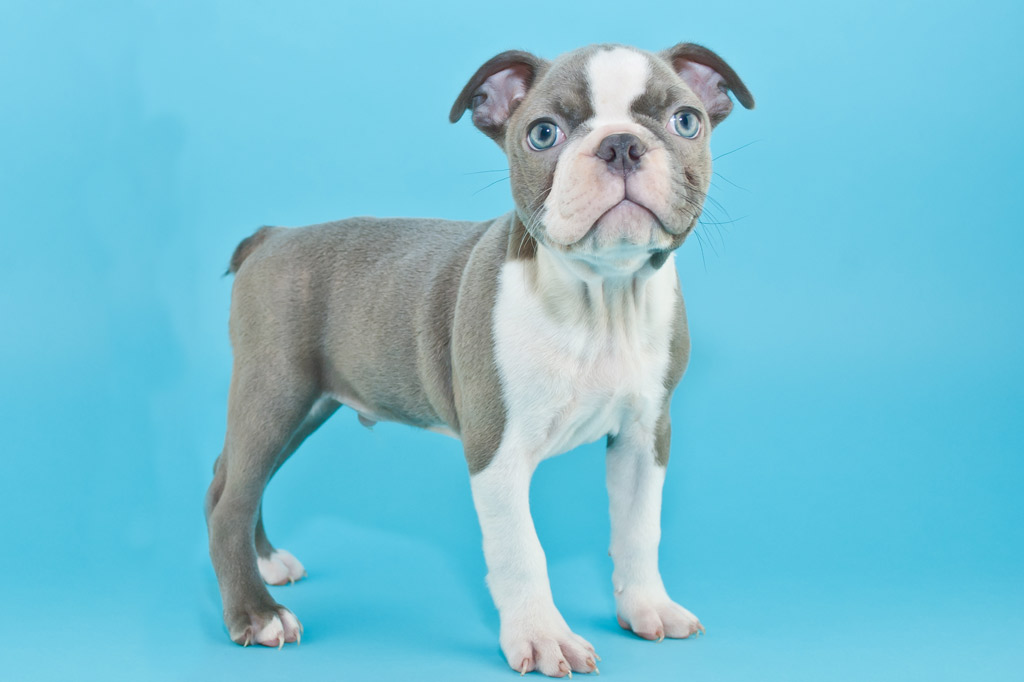
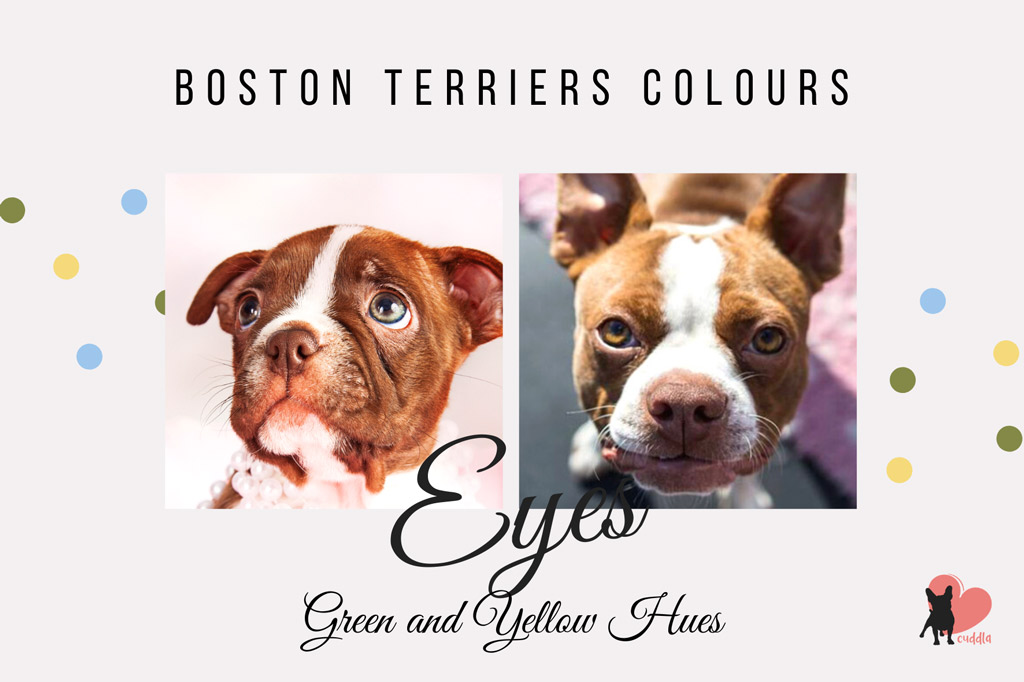
Do Blue Boston Terriers Have Health Problems?
Does the colour of your Boston Terrier matter for long term health?
There is concern about hair loss, skin problems, allergies and even deafness in Blue Boston Terriers and many other coloured Bostons.
Albino Boston Terriers, for instance, can have higher cases of skin allergies and irritations. Also, their risk of sunburn seems to be higher.
According to this study, there’s a relation between the coat and the eye pigmentation and deafness in dogs. This fact also affects Boston Terriers.
“Because of the complexity of the genes and signalling pathways affecting pigmentation, and the number of mutation targets, the identification of a gene responsible for pigment-associated deafness is no simple task.”
The Genetics of Deafness in Domestic Animals, by George M. Strain.
Another study also affirms that the coat colours associated with the highest risk of deafness are:
- White.
- Piebald (much white with some spotting).
- Roan (white or grey hairs mixed through the coat).
- Merle (desaturated colours, especially where blacks become greys or blues).
So, Boston Terriers with predominantly white or all-white coats (like Albino Boston Terriers) and Merle Boston Terriers have a higher incidence of unilateral (single ear) or bilateral (both ears) deafness.
“Among those Bull Terriers who are white, the rate of congenital deafness is 20%, while for those with color patches it is only around 1%.”
Your Dog’s Coat Color Predicts His Hearing Ability, by Stanley Coren PhD., DSc, FRSC.
If a breeder is selling a “Blue Boston Terrier,” “Grey Boston Terrier” or “Lilac Boston Terrier” you should ask yourself this:
“Why is the breeder producing dogs that are ineligible to compete in dog shows?”
Often, breeders do this because those colours are popular with puppy buyers, disregarding the breed’s health, temperament, etc.
Breeding rare coloured Bostons Terriers because of their looks is for the most part a sign of poor and irreputable breeding practices. Breeding for colour instead of temperament, health, or structure is not responsible.
However, if you are considering adopting a blue Boston, go for a reputable breeder that not only breeds because of colour, but also for temperament and health.

Boston Terrier Colours
Are Boston Terriers always black and white? By now, you probably have figured out that this is not the case.
But, what are the different colors of Boston terriers?
- Black and white Boston Terrier.
- Brindle and white Boston Terrier.
- Seal and white Boston Terrier.
- Blue or grey and white Boston Terrier.
- Lilac and white Boston Terrier.
- Red and white Boston Terrier.
- Cream and white Boston Terrier.
- Albino Boston Terrier.
- Liver or brown and white Boston Terrier.
- Merle Boston Terrier.
- Solid black Boston Terrier.
- Solid brindle Boston Terrier.
- Solid seal Boston Terrier.
- Fawn or champagne (pale red) and white Boston Terrier.
- Splash Boston Terrier (white with black markings).
Let’s have a look at the most common variations (source) and which ones are included in the official breed standards (source).
Black and White Boston Terrier
This is the classic Boston Terrier look, also known as “The Tuxedo Look.” This signature look is responsible for the breed’s nickname as “The American Gentleman.”
Black and white Bostons have a black coat with white markings. They have a white muzzle band, white blaze between the eyes, and white forechest.
Purebreds should also have a black nose and brown eyes. This colour combination is included on the breed standards.
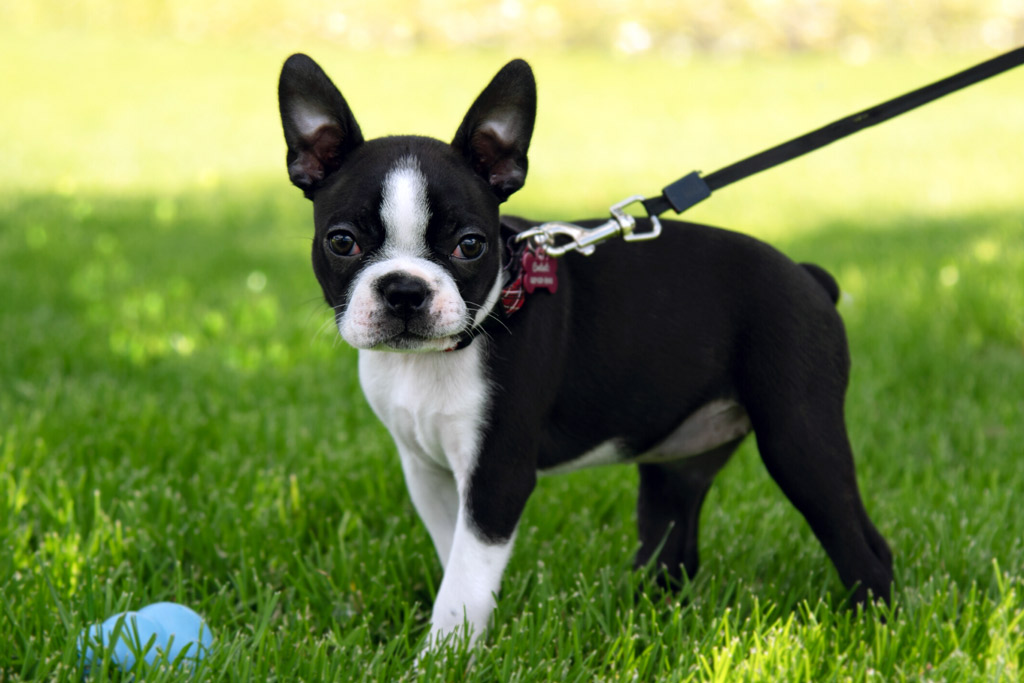
Brindle and White Boston Terrier
Brindle is not defined genetically as a colour; it’s a pattern.
This pattern can occur within black, dilute (lilac and blue) and brown coats.
There are many varying shades of brindle, where the stripping can look extreme (obvious pattern) or minimal (very light brindle pattern in the coat).
Standards dictate that the coat should be black with a brindle pattern and white markings (white muzzle band, white blaze between the eyes, and white forechest).
Purebreds still have a black nose and brown eyes. This colour combination is also part of the breed standards.
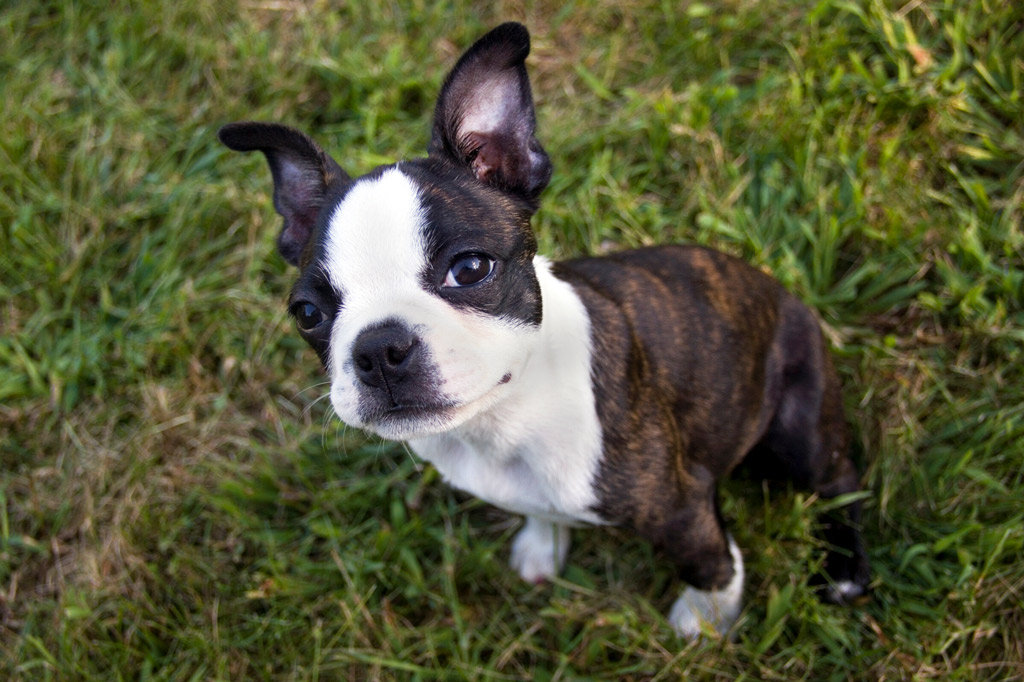
Seal and White Boston Terrier
Seal colour is defined by the American Kennel Club Boston Terrier Breed Standard as: “appears black except it has a red cast when viewed in the sun or bright light” (source).
Seal can look like dark brown (not red or medium brown) due to those red undertones.
Black seal is the only accepted colour by the AKC. Other shades like liver (brown), red or fawn (light red) are not admitted.
Boston Terriers have a seal coat with white markings (like the two combinations above). The required splashes of white are white muzzle band, white blaze between the eyes, and white forechest.
Again, purebred Boston Terriers have a black nose and brown eyes. This is the third and last colour combination that is accepted in the breed standards.
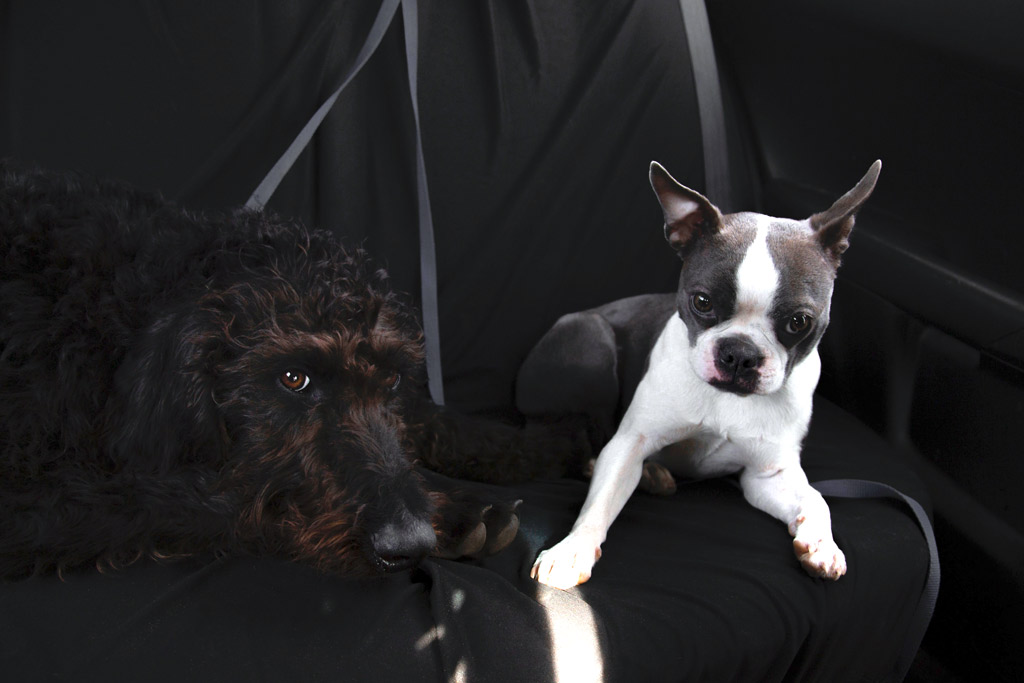
Non-Standard Coloured Boston Terriers
In summary, the breed standards today indicates that Boston Terriers should have black, brindle or seal coat with white markings (banded muzzle, blaze between the eyes, and a splash on the chest).
These purebred Boston Terriers should also have a black nose and brown eyes.
That’s why other colours (from solid colours to other colour combinations) are not recognized by the AKC. These include:
- Blue or grey and white.
- Lilac and white.
- Red and white.
- Cream and white.
- White (Albino Boston Terrier).
- Liver or brown and white Boston Terrier.
- Merle Boston Terrier.
- Solid black.
- Solid brindle.
- Solid seal.
- Fawn or champagne (pale red) and white.
- White with black markings (Splash Boston Terrier).
Also, the following traits are reasons to disqualify a Boston Terrier:
- Blue eyes or traces of blue.
- A Dudley nose (flesh-coloured).
- Docked tail (purebreds are born with a naturally shortened tail).
Let’s see some examples of disqualified Boston Terrier coat colours:
Red and White Boston Terrier
This Boston has a red coat with the same placement for the white markings. The shades of red can vary from bright copper to deeper red.
Basically, their coats, noses and pads self-match.
So, unlike the breed standard Bostons, their nose has a red colour and the eyes can be amber (yellow) or hazel (brown). But, when they are pups, they can be green (like in the photo below).
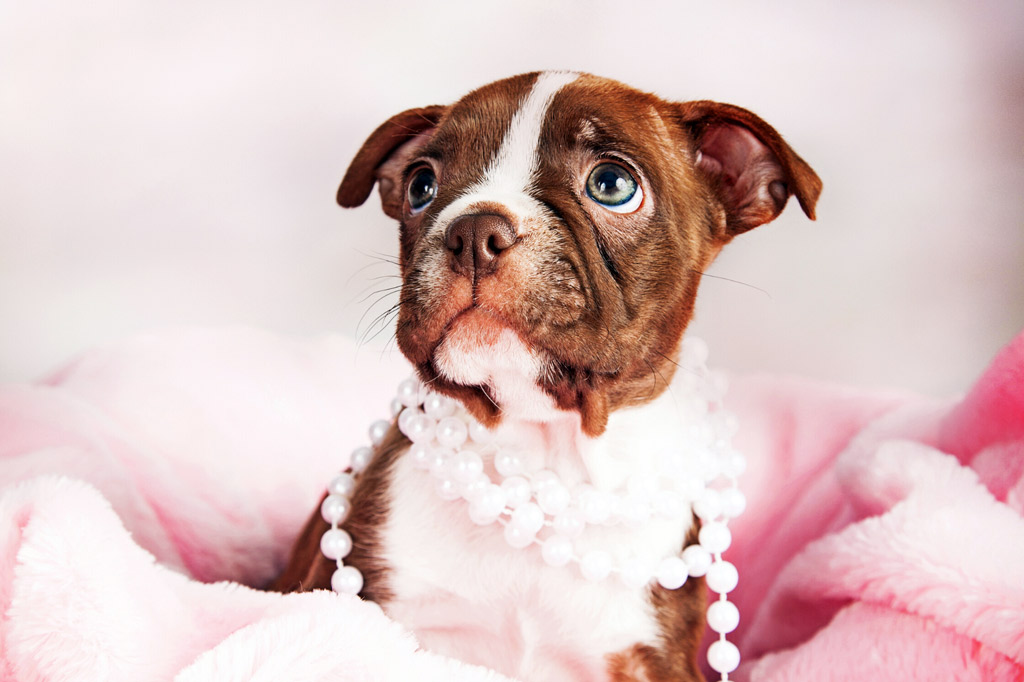
Liver or Brown and White Boston Terrier
This colour combination can be referred to as liver and white, brown and white, or chocolate and white.
Their coat looks darker than the one of red Boston Terriers. They have a brown coat with the same placement for the white markings.
Their nose has a brown colour and the eyes can be amber (yellow) or hazel (brown). But, when they are pups, they can be blue or green.
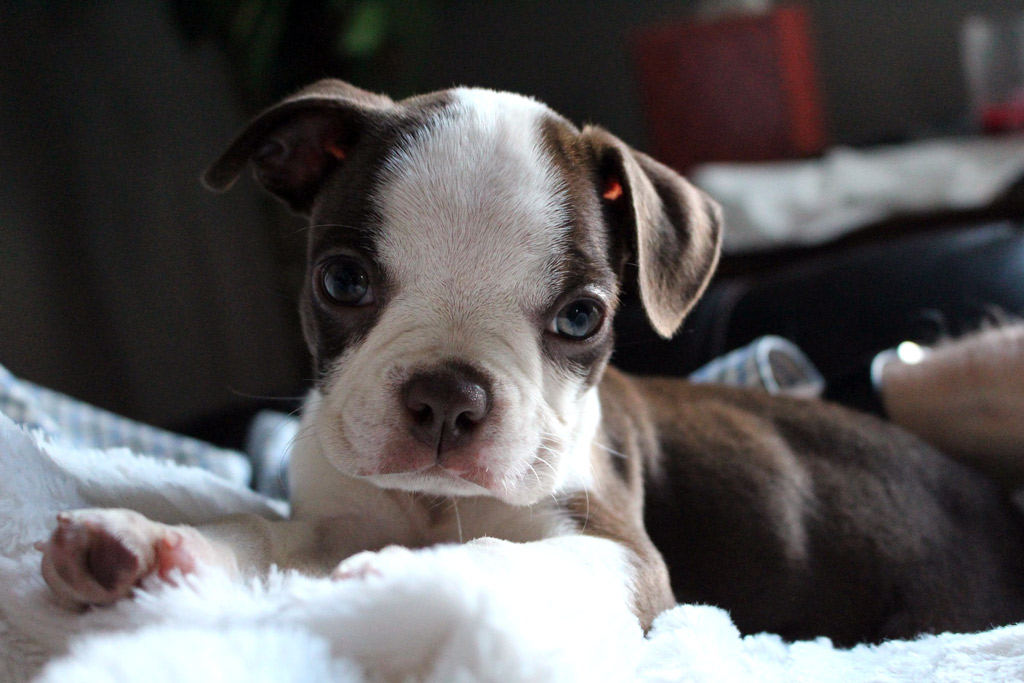
Fawn Boston Terrier
There are many shades of fawn, from light fawn (looks like champagne) to darker fawn (looks like light red). The main pigmentation of this rare variation is black, although there other options.
Fawn Bostons have a fawn coat with white markings (banded muzzle, blaze between the eyes, and a splash on the chest).
But, the most distinctive attribute is their masking and banding of darker hairs. Basically, they have intermingled black hairs on their fawn coat. Some have a black mask (like the little cutie in the picture below) that reminds us of the Boxer-like mask.
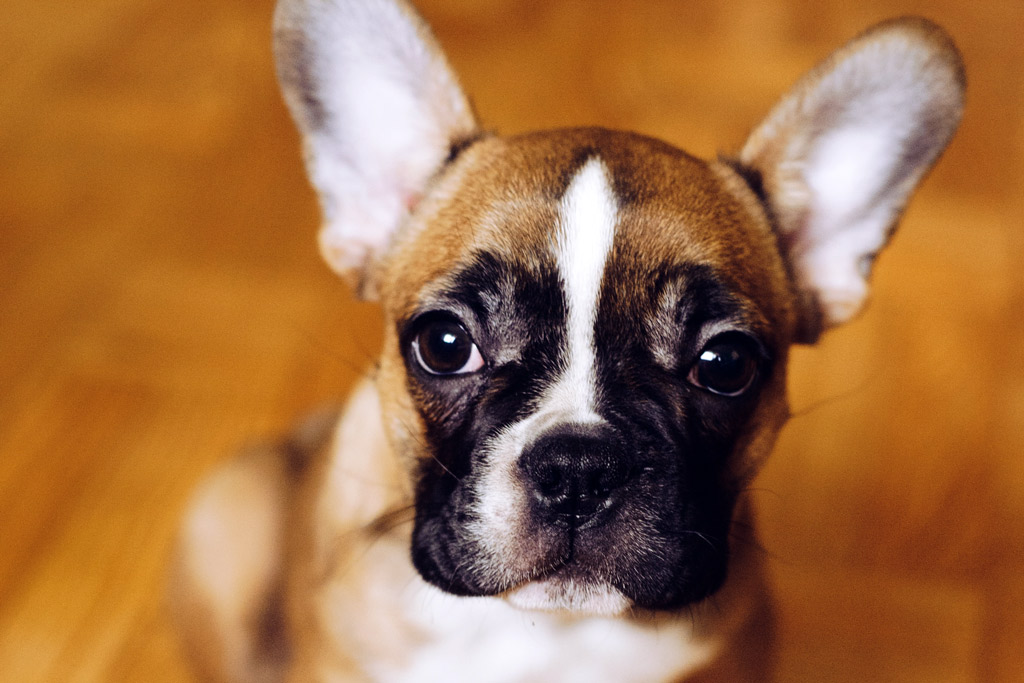
Cream and White vs Albino Boston Terrier
Albinos are not cream and white Boston Terriers, although the pups can be confused at first sight by those who are not familiar with the wide range of colours in Boston Terriers.
Whilst they are both born looking pale (solid white), cream Bostons’ coat colour gets darker with age.
However, albinos simply lack colour. Albinism is not a coat colour, but a lack of pigmentation that produces a white-appearing coat.
Albino Boston Terriers, for instance, have a lack of pigment or colouration. They have a white-appearing coat. The Cypress Farm Kennel explains that there are two types of albinos within the Boston Terrier breed:
- Cornaz Albino Boston Terriers: It’s not the typical albino dog (solid white with red eyes). Part of their coat will be lightly coloured (almost colourless to an off-white colour) in the case of the traditional tuxedo look. For this reason, they can get confused as cream and white Boston Terriers when newly born. But, by week 3, their lack of pigment on nose/iris/paw pads would clearly point to albinism (it can look pink or flesh-toned).
- Leucistic Albino Boston Terriers: They are much less common than Cornaz Albinos. They lack all pigment of the coat, i.e., they are solid white.
Cream Boston Terriers have greyish nose and brown eyes. But Albinos have a flesh tone nose.
Leucistic Boston Terriers have pink/translucent eyes and Cornaz Bostons have blue-green eyes.
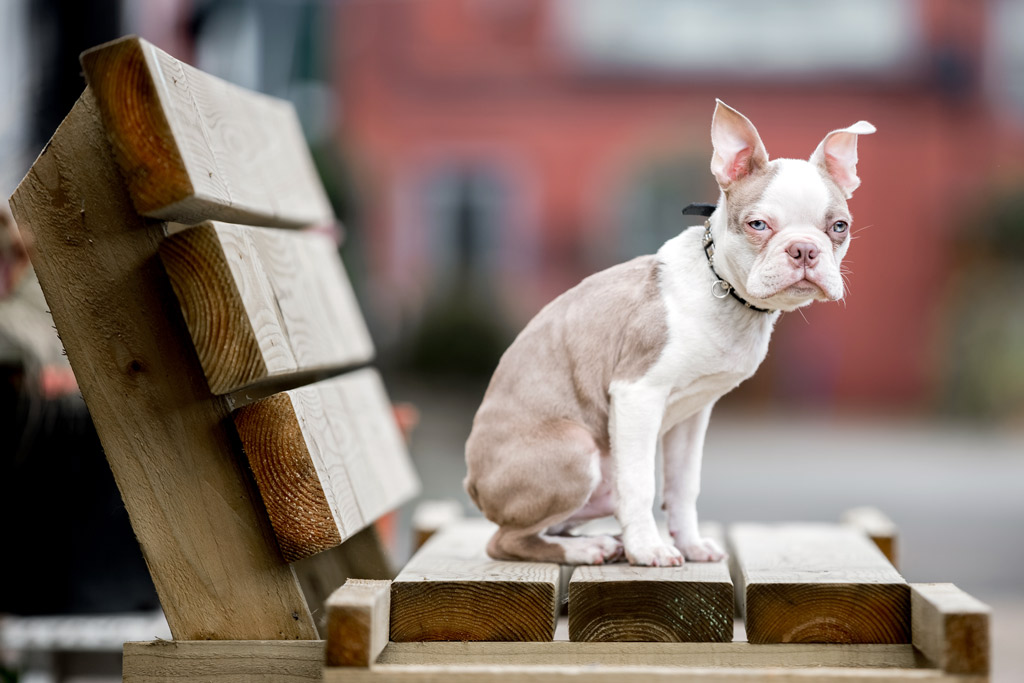
Merle Boston Terrier
Merle, sometimes also called harlequin or dapple, is a controversial Boston Terrier genetic pattern. This is because the same gene that controls this coat colour can produce eye and ear disorders (deafness).
Merle is a canine coat colour pattern that is naturally occurring to only a few breeds. That’s why Merle Boston Terriers are mixed since this pattern doesn’t naturally exist in this breed.
So, there’s no such thing as a purebred Merle Boston Terrier and it’s impossible to register them in the AKC.
This is a clear example of unethical breeding of Boston Terriers. The breeding goal is for their looks, disregarding the dog’s health.
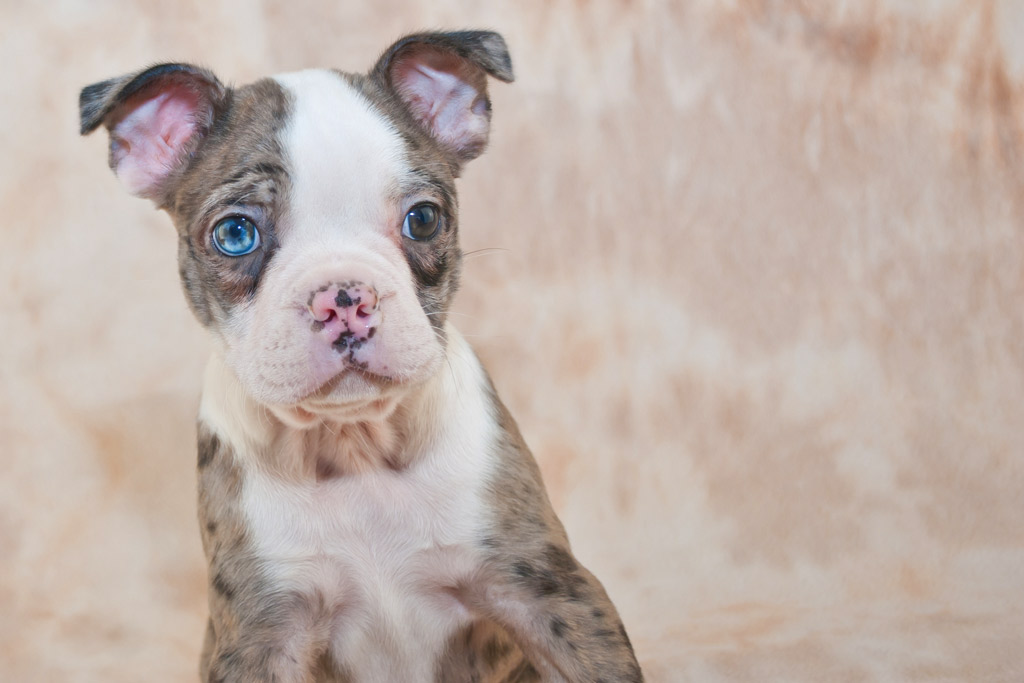
Boston Terrier Breed Standards
If you are looking to get a Boston, it’s a good idea to get familiar with the breed standards before moving ahead to finding a reputable breeder.
Why? If you don’t know what the breed standards are for the Boston Terrier, you will be at a loss when examining puppies. You want to be able to identify a purebred Boston Terrier from a crossbred.
Plus, an unethical breeder might try and take advantage of you.
Breeders can register their Boston Terriers claiming that they are purebred when they might not be.
As you can see from the Boston Terrier colours guide, there’s a wide colour rainbow out there. So, getting to know this breed’s standards helps to make an informed decision.
Also, rather than only focusing on the colour, you would want to make sure that the Boston Terrier puppy that you choose is healthy and has been bred while keeping temperament and health in mind.
According to the AKC, the official Boston Terrier breed standards state the following:
General Appearance
A purebred Boston Terrier is:
- Lively, highly intelligent and active.
- Smooth-coated, short-headed, and short-tailed.
- Brindle, seal or black in colour and evenly marked with white.
- Compactly built and proportioned, the body is rather short and muscular. The head is in proportion to the size of the dog.
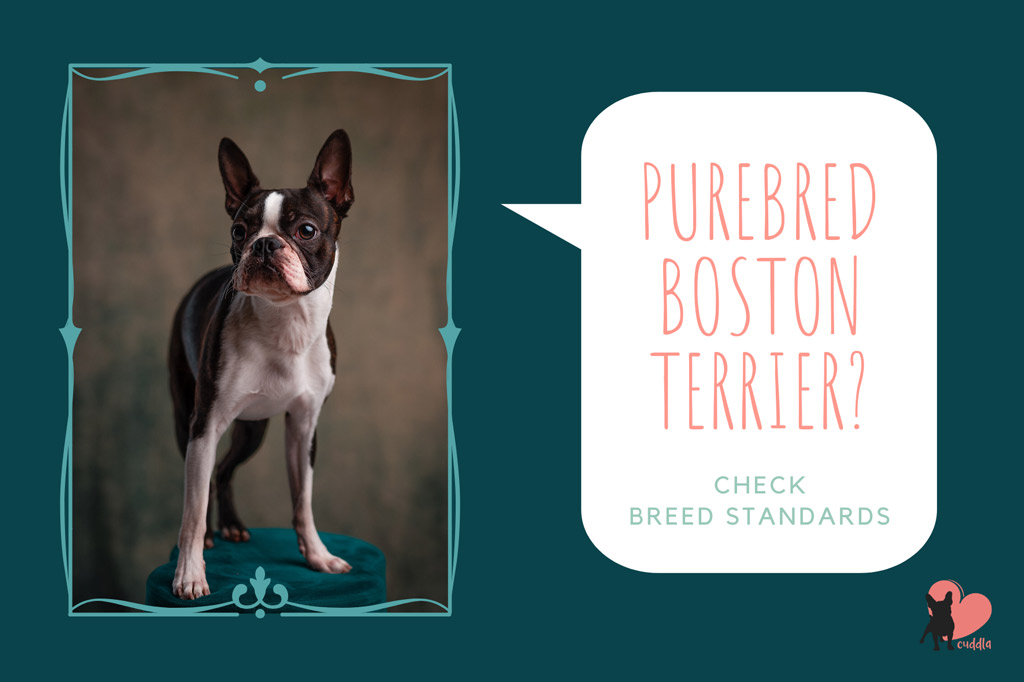
Size, Proportion, Substance
A Boston Terrier belongs to one of three weight classes:
- Under 15 pounds.
- 15 to 20 pounds.
- 20 to 25 pounds.
In terms of proportion:
- The length of the legs is in balance with the length of the body.
- Although a sturdy dog, it’s not a chunky dog. Bone and muscles are proportioned to the dog’s weight and height.
- The only difference between male and female Boston Terriers is a slight refinement in the bitch’s conformation.
Read also: Boston Terrier Growth Stages and Puppy Development Chart.
Head
- The skull is flat on the top and square in shape.
- Boston Terriers should have an alert and kind expression in their face indicating a high degree of intelligence.
- The eyes are large, round and situated wide apart. Eyes are dark in colour; blue eyes or any trace of blue is enough to disqualify them.
- The ears are small and stand erect.
- The muzzle and snout are short, square, and wide.
- The nose is black and wide.
- The teeth are short and the bite is even or slightly under the muzzle.
Read also: Boston Terriers Ears – When Do They Stand Up? and Boston Terrier Eyes – 10 Problems and 6 Prevention Tips blog posts.
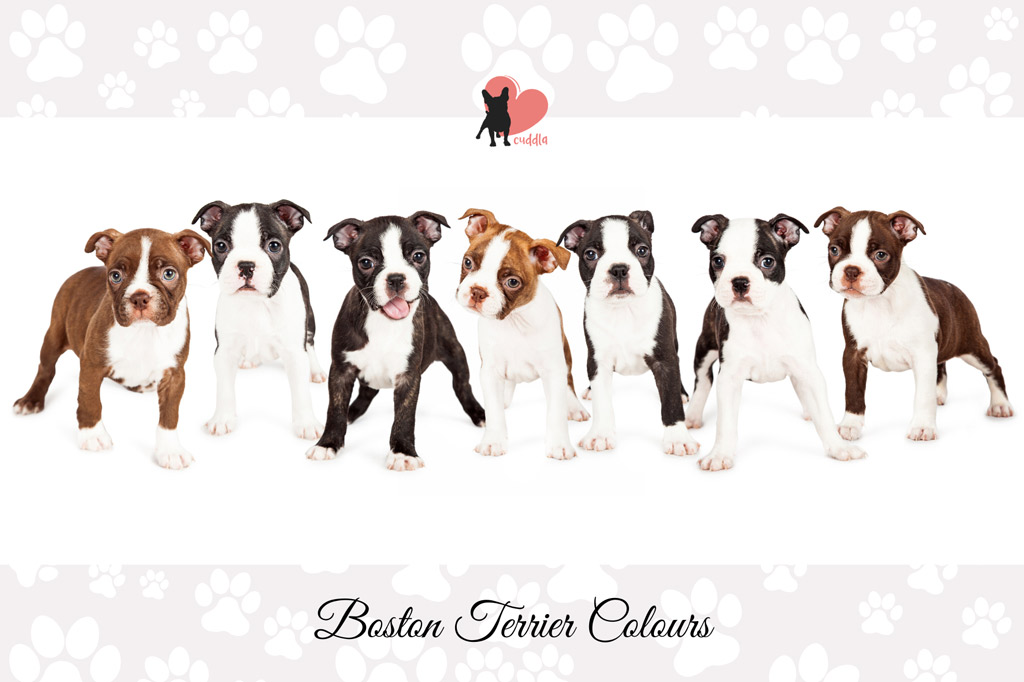
Neck, Topline and Tail
A Boston Terrier should have:
- A slightly arched neck.
- A level topline.
- A deep chest.
- The tail is set on low (not carried above the horizontal), short, and fine. The shape of the tail can be straight or screw.
Read also: Do Boston Terriers Have Tails? Breed Standards & Tail Facts.
Forequarters and Hindquarters
- The shoulders are sloping and well laid back.
- The elbows and the feet stand neither in nor out.
- The thighs are strong, muscular and bent at the stifles.
Coat, Color and Markings
- The coat is short, smooth, and fine in texture.
- A Boston Terrier can have a brindle, seal (black with a red cast in direct sunlight), or black coat with white markings.
- Required markings: White muzzle band, white blaze between the eyes, and white forechest.
Temperament
The Boston Terrier is:
- Friendly.
- Lively.
- Intelligent.
Read also: Boston Terriers Personality – What’s It Like to Own One?
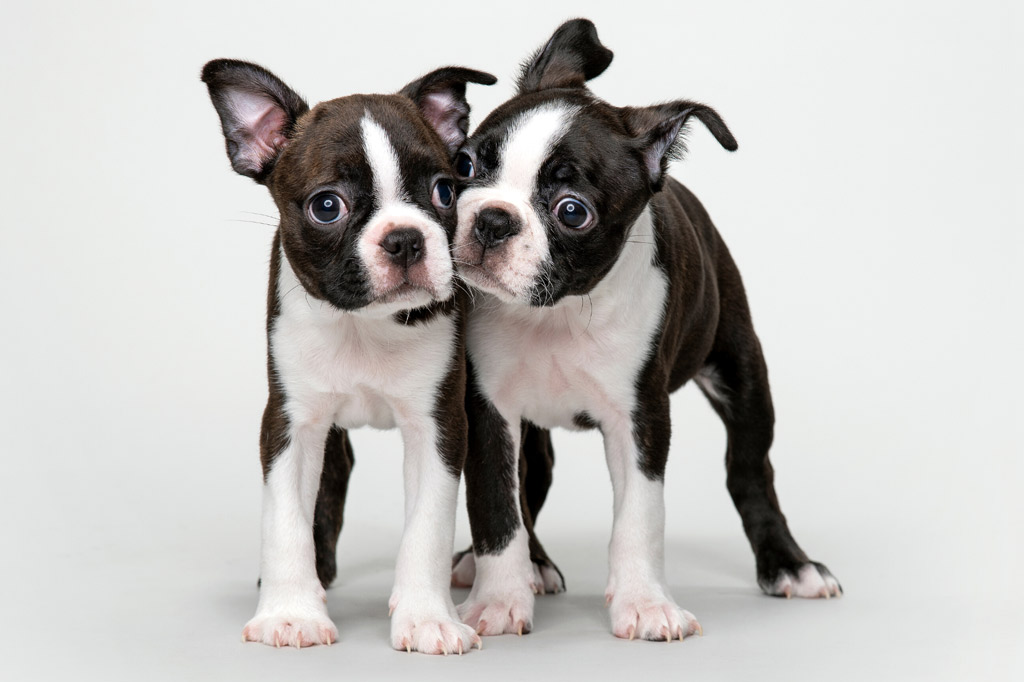
Boston Terrier Crosses and Mixes
Apart from colour variations, there are also size variations in Boston Terriers.
Miniature Boston Terriers, (also known as Teacup or Toy Boston Terriers), are purebred Bostons that are smaller than the breed standards. This is usually by design, i.e., breeding small Bostons.
The controversy about these breeding practices goes even further than colour and size, as we humans start to mix and match dogs, creating designer cross dogs.
Here’s a list of the most common Boston Terrier mixes (source):
| Breed Mixed with Boston Terrier | Boston Terrier Cross Name |
|---|---|
| Beagle | Boglen Terrier |
| Bichon Frise | Bostchon |
| Brussels Griffon | Brusston |
| English Bulldog | English Boston Bulldog |
| Cairn Terrier | Cairoston |
| Chihuahua | Bochi |
| Chinese Shar-Pei | Sharbo |
| Cocker Spaniel | Boston Spaniel |
| Dachshund | Bodach |
| English Bulldog | English Boston Bulldog |
| French Bulldog | Frenchton |
| Jack Russell Terrier | Bojack |
| Japanese Chin | Boston Chin |
| Labrador Retriever | Boston Lab |
| Lhasa Apso | Bosapso |
| Miniature Pinscher | Bospin |
| Miniature Schnauzer | Miniboz |
| Papillon | Bostillon |
| Pekingese | Bostinese |
| Pomeranian | Pomston |
| Poodle | Bossipoo |
| Pug | Bugg |
| Rat Terrier | Brat |
| Scottish Terrier | Scobo Terrier |
| Shiba Inu | Shibo |
| Shih Tzu | BoShih |
| Siberian Husky | Siberian Boston |
| Toy Fox Terrier | Foxton |
| West Highland White Terrier | Bostie |
| Yorkshire Terrier | Boston Yorkie |
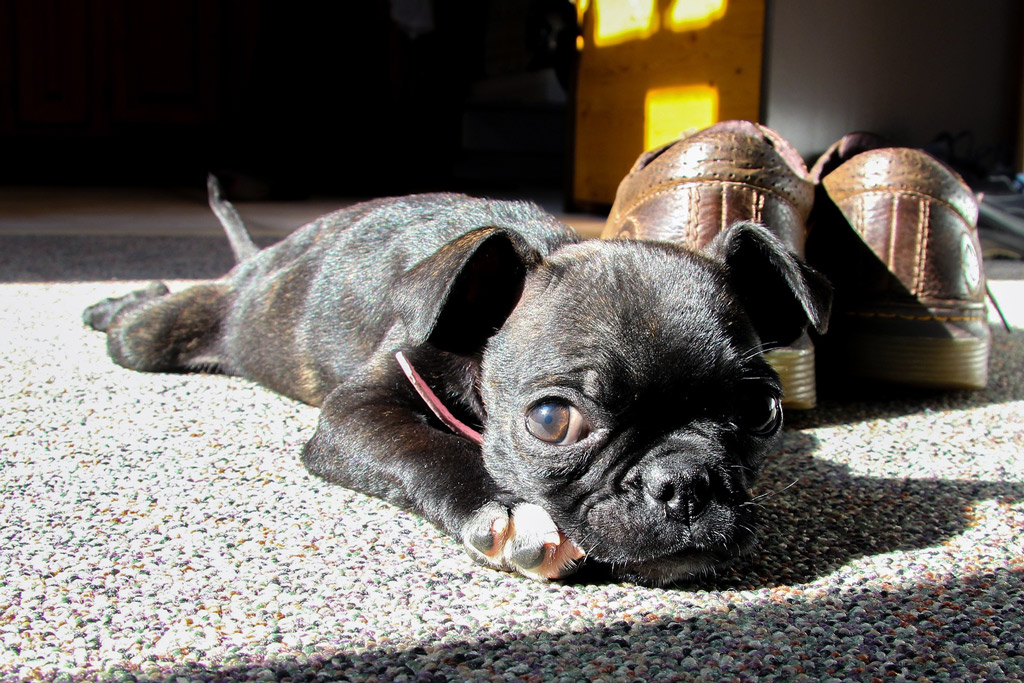
Don’t Forget…
Watching your pup grow and develop is a precious thing. Time can pass by pretty quickly… and before you realize, your Boston is not a puppy anymore!
This is why cherishing each moment with your pooch keeps you connected to what you have. One of the ways I make sure to do this is to have little reminders around or add a doggie decor touch at home (or in the office).
Here are some sweet and stylish ideas for Boston Terrier lovers:

I have a question!
I recently purchased a lilac boston terrier puppy and we have not taken him home yet. Do the colors of the coat change the tempermant of the dog usually? This has been sort of bothering me as I used to have a by the book boston terrier who was black and white, and he was my best friend. I just want to make sure I am making the right decision. Thank you for your input!
Kindest regards
Ashley
Hello Ashley, great to see your question and congrats on your pup!
It’s mostly the parent’s behaviour i.e. genetics, that contributes to a puppy’s temperament rather than color of the coat. Because some breeders will place more importance on the coat color than health and genes, this is where the concern is. You should be able to access medical records and history of the mum and their previous puppies from the breeder, which will give you more confidence with your decision. Also, a good breeder should be able to tell you what can be expected. Don’t be shy to ask questions! Check out my article for more: Finding a Reputable Boston Terrier Breeder & 16 Questions to Ask
So on one side is genetics, but once you receive your puppy you’ll be the main influencer i.e. training. Lastly, you will hopefully be bringing your puppy home no earlier than 8 weeks, as he should stay with the mum and littermates up till 8-10 weeks from birth.
Hope that helps!
Please change the title of this article. These colors are not RARA and by stating this, you are dupping people into paying Puppymills huge amounts of money for a poorly bred puppy of color. Ethical breeders that are not trying to scam people out of tons of money, never call These colors rare. The use of the term rare color should send a buyer running from the breeder. The only rare color in Bostons right now is merle because it is not a foundation color and is not true to the breed! These are now all registerable colors and therefore not rare. Perhaps you could change the title to…The many colors of Boston Terriers. Thank you!!!
Thanks for the feedback, Hilaree. It’s a very good point and we definitely don’t want to encourage the industry of unethical breeding. We’ll take what you’ve suggested into consideration!!
My brother has a black and white female breed for the first time and the male father is a black and white Boston but in there litter there was 2 black and whites and 3 gray and whites! and there was no bad breeding habits!!